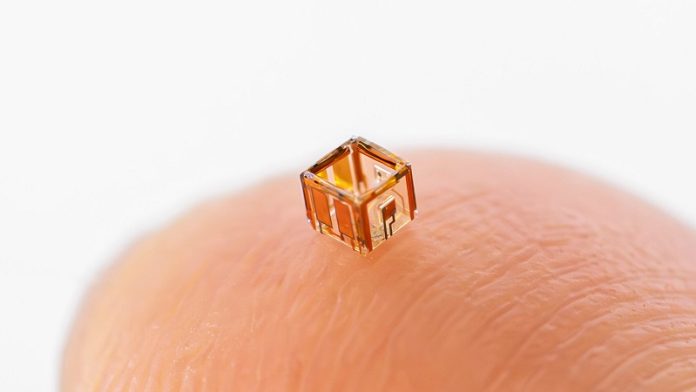
Imagine robots so small you could barely see them, yet smart enough to sense their environment, talk to each other, and work as a team.
That is exactly what a group of scientists at Chemnitz University of Technology in Germany has achieved.
They have created a new type of microrobot, called “smartlets,” that can move, communicate, and collaborate in water—all without needing bulky external control systems.
Each smartlet is only about a millimeter in size, yet it carries its own electronics, sensors, and energy system.
Unlike earlier microrobots that had to be guided by external magnetic fields or large wireless systems, these tiny devices are completely self-contained.
They are powered by miniature solar cells, steered by silicon microchips, and communicate with each other using tiny lights and detectors.
Professor Oliver G. Schmidt, Scientific Director of the Research Center MAIN at Chemnitz, explains: “For the first time, we show a microrobotic platform that doesn’t just move in water, but also senses its surroundings and talks to other robots in a fully autonomous way.”
The findings were recently published in Science Robotics.
The way the smartlets are built is just as fascinating as what they can do. The researchers use an origami-inspired method, starting with flat patterned materials that fold themselves into hollow 3D cubes.
These cubes provide enough surface area to hold all the components the robots need—solar cells to harvest energy from light, processors to store logic and instructions, and tiny LEDs and photodiodes for communication.
The flexible folding also creates interior cavities that the robots can use for movement.
When placed in water, the smartlets can rise and sink by generating bubbles inside their hollow bodies. By carefully controlling these bubbles, they can move in different directions.
At the same time, their micro-LEDs can send out light pulses, which other nearby smartlets can detect. This allows them to “talk” to each other and even share instructions.
For example, if one smartlet receives a light signal, it can decode the message using its onboard processor and then trigger a response in the group, such as moving together in a synchronized pattern.
Dr. Vineeth Bandari, another lead researcher, says, “Using light for both energy and information gives us a very compact and scalable way to create distributed robotic systems.”
One of the most important advances is that these robots do not rely on outside cameras, magnets, or antennas. Instead, everything happens locally.
Each robot has its own chip with custom-coded logic that lets it interpret signals and decide how to respond. This decentralized control means they can behave like a swarm, coordinating with each other while still remaining flexible.
The smartlets were made possible thanks to earlier work at Chemnitz University on attaching tiny silicon chiplets, called lablets, onto flexible films. This “soft bonding” approach makes it possible to combine advanced microelectronics with foldable, origami-inspired materials.
The possible uses for these robots are wide-ranging. Because they are small, soft, and biocompatible, they could one day be used in medical fields, such as monitoring body fluids, delivering drugs, or performing minimally invasive diagnostics.
They could also help monitor water quality in lakes and rivers, inspect delicate structures, or form part of distributed sensor networks. Their ability to interact like colonies makes them especially promising for tasks that require cooperation, adaptation, and collective intelligence.
Dr. Yeji Lee, who contributed to the project as part of her doctoral research, points out that this is just the beginning. “We are working to add more abilities, like chemical and sound sensors, so these smartlets can adapt even better in complex environments.”
Looking ahead, the researchers imagine that these microrobots could develop into systems that act like digital colonies of living creatures. Just as some animals, such as siphonophores, are made up of different specialized units working together, future smartlets could divide tasks among themselves—some focusing on sensing, others on moving, and others on communication.
Professor John McCaskill, another co-author, notes that while the team is not creating artificial life, they are showing how distributed intelligence and modular design can mimic the behaviors of natural systems. “We’re starting to see how robotic collectives can adapt, communicate, and coordinate, much like living organisms do.”
By building microrobots that are self-contained, communicative, and adaptable, the Chemnitz team is opening the door to a new era of robotics.
These tiny machines may one day explore water droplets, navigate inside tissues, or even form miniature ecosystems of their own. What once seemed like science fiction—swarms of intelligent, cooperative microrobots—may soon become part of our real world.



